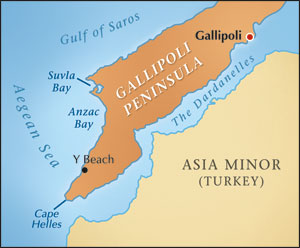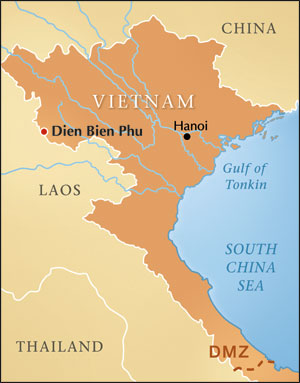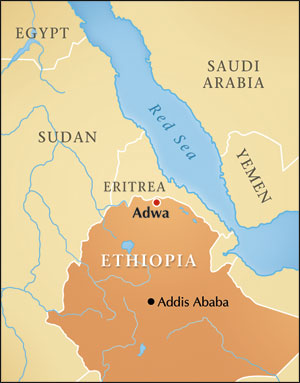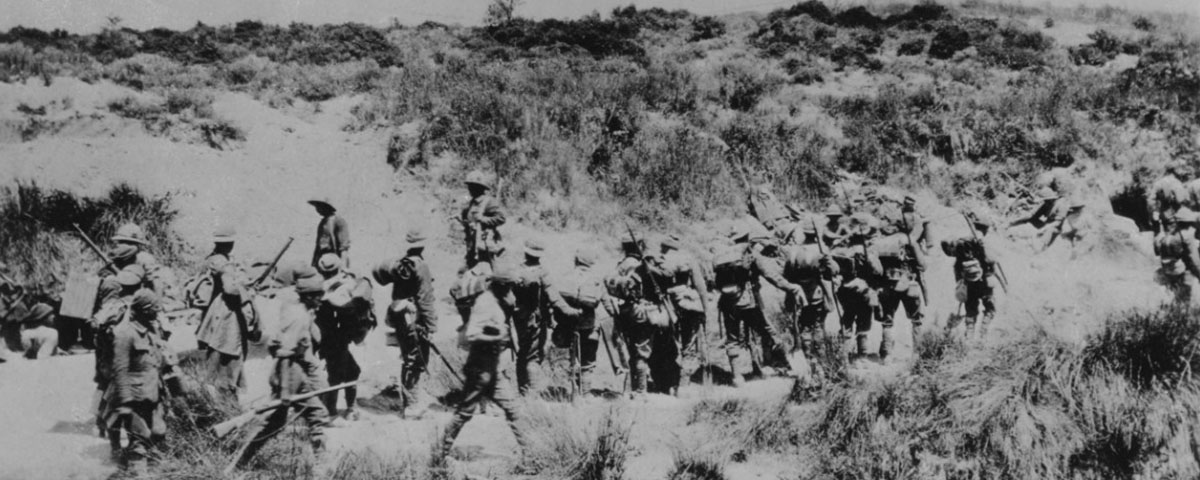Imagine how much longer and bloodier World War II might have been had Admiral Yamamoto not filled the decks of his vulnerable carriers at Midway with fully fueled airplanes awaiting ordnance. What if Hitler, despite his anger at the bombing of Berlin, hadn’t switched tactics from downing Spitfires to uselessly attacking London?
Battlefield blunders can be as decisive as brilliant tactics, whether they suddenly advance tribal factions toward nationhood, punish a proud military unaccustomed to losing or temporarily swing the balance of power in an utterly unexpected direction.
That said, following are five losers who might have wished for a do-over.
Hamilton at Gallipoli

During World War I, German General Erich Ludendorff famously observed, “The English fight like lions.” “Yes,” a staff officer famously replied, “but they are led by donkeys.”
British General Sir Ian Hamilton might not have been a full-fledged ass, but he was certainly a bumbling Ferdinand the bull—shy, courteous and overly accommodating. Unfortunately, Lord Kitchener, Britain’s Secretary of State for War, gave him command of the 1915 invasion of Gallipoli—the amphibious landings by British, French and ANZAC (Australian and New Zealand Army Corps) troops intended to take Turkey, a German ally, out of the war. The campaign demanded an assertive, tactically brilliant, take-charge commander. Instead, the Allies got a kindly uncle who really didn’t want to interfere with his brigadier nephews.
Not that a promising young Winston Churchill had done any better. As First Lord of the Admiralty in 1915, he proposed that a task force of 18 aging battleships charge through the Dardanelles, the narrow 38-mile-long strait that led toward the Turkish capital at Constantinople (modern-day Istanbul). Forts flanked the high-bluffed Gallipoli Peninsula west of the strait, so Churchill’s strategy was akin to taking a convoy of vintage Cadillacs on a thunder run through central Baghdad. The British lost five battleships, mainly to mines but also to Turkish coast artillery.
This should have been a hint, not that Gallipoli was impregnable, for the Turks really didn’t have a modern army or much in the way of good artillery, but that the commanding terrain made a frontal attack potentially suicidal. Indeed, the Greeks—the Turks’ neighbors and longtime adversaries—had formulated a war plan in case the Gallipoli Peninsula ever needed to be attacked, and it called for 150,000 men. Lord Kitchener scoffed at that estimate. Johnny Turk would cut and run at the first sign of the Allies, he insisted, and half as many troops would do just fine.
Thus, early on the morning of April 25, 1915, Hamilton launched his enormously ambitious amphibious landing. An outline of the beachhead assault might read like a description of the D-Day landings were it not for the absence of any specialized landing craft. Armored assault boats did exist back in England, but they remained a well-guarded secret; heaven forfend invaders would use them and thus spill the British beans. Instead, huge warships towed ponderous strings of cockleshells—essentially lifeboats—toward shore, then split the strings and transferred the towing job to slow, shallow-draft launches. Oarsmen stroked the final few yards onto the beaches.
The action most often memorialized in paintings of the landing was the beaching of the old steamer River Clyde to allow soldiers to emerge from its sally ports (doors along the hull at the waterline) and stroll ashore on gangplanks. Unfortunately, it was equally easy for Turkish machine gunners on the heights to pick off troopers one at a time as they popped from the sally ports like mechanical ducks in a shooting gallery. Of the first 200 soldiers to step from the ships, just 21 made it to the beach alive.
General Hamilton chose the battleship HMS Queen Elizabeth, the grandest ship available, as his command vessel. While it made sense to oversee the battle from somewhere offshore, an oceangoing capital ship engaged in long-range bombardment wasn’t the ideal platform. Hamilton was too far from the beaches to see what was going on (chaos, for the most part), and his corps commanders were also literally and figuratively adrift during the crucial early hours of the invasion. Communications both ashore between units and from ship to shore ran the gamut from primitive to nonexistent, so junior officers on the beach were largely left to their own devices.
Two thousand Brits had landed at a providentially undefended spot called Y Beach and climbed the cliffs unopposed. Having nothing else to do, no commanders to enact Plan B and no direction from Hamilton, they simply hunkered down and boiled water for cuppas. They heard distant firing but had no idea it signified the slaughter of ANZACs at the beachhead to their north. While the Turkish defenders were relatively few in number, they commanded the high ground with machine guns. A flanking maneuver by 2,000 Tommies could have ended the battle in minutes, but it was not to be.
To this day ANZACs haven’t forgiven the English for “sittin’ on their arses brewing tea and havin’ a smoke” while Aussies and Kiwis who had never before experienced war were dying by the hundreds only hours away.
Due to Hamilton’s haphazard planning, the beachheads ANZAC forces were able to secure were cramped and highly vulnerable. In fact, British corps commander General Sir William Birdwood suggested an immediate evacuation, to which Hamilton replied: “There is nothing for it but to dig yourselves right in and stick it out….You have got through the difficult business, now you have only to dig, dig, dig until you are safe.” (Australians have since borne the fond nickname “Diggers.”) At one point, the clueless Hamilton wired Kitchener, “Thanks to the weather and the wonderfully fine spirit of our troops, all continues to go well.”
After eight months of pointless trench warfare, Hamilton’s forces evacuated the bloody beaches. Half a million men on both sides had died for nothing in a true standoff— combined British and French losses numbered just 700 men more than Turkish losses. Each year on April 25, the invasion anniversary, Australia and New Zealand celebrate ANZAC Day, marking their painful emergence into true nationhood.
Burnside at Fredericksburg

The Battle of Fredericksburg was a humiliating meat-grinder of a defeat for the Union Army, and the fault lies squarely with General Ambrose Burnside. Burnside admitted as much after the war, while many another general played the blame game. The man would be forgotten today but for the fact that he lent his name to excessive cheek hair. Yes, sideburns were indeed originally called burnsides, and Burnside himself looked like he had a pair of squirrels hammocking between his nose and ears.
President Lincoln gave Burnside command of the Union Army of the Potomac because General George McClellan had turned out to be diffident, slow-moving and cautious. Burnside, also a West Pointer and among McClellan’s best friends, was determined not to make the same mistakes.
Unfortunately, he made others.
In December 1862, Robert E. Lee’s rebel forces were precariously divided at Fredericksburg, Va., a rail terminus about 50 miles from Richmond, the crucial Confederate capital. Burnside felt that if he moved rapidly and decisively, he could end the war by eliminating the defenses at Fredericksburg and taking Richmond. Burnside commanded some 118,000 troops—the largest army in U.S. history up to that time.
Some of Lee’s troops were defending Fredericksburg itself; the rest, under the famed T.J. “Stonewall” Jackson (so named for his stubborn resistance at the 1861 First Battle of Bull Run), were about three and a half miles south at Prospect Hill. A good tactician might have assessed the situation and said, “Take Prospect Hill pronto with your superior numbers, turn north and finish off Fredericksburg with a flanking maneuver, then on to Richmond. Game over.”
Instead, Burnside chose to confront the Fredericksburg defenders with his main force and send General George Meade to deal with the rebels at Prospect Hill. Driven back by Jackson, Meade begged for reinforcements, but by that time Burnside was busy head-butting Fredericksburg.
Burnside first tried to traverse the Rappahannock River with pontoon bridges—Lee had burned all the existing spans—but Confederate sharpshooters on the far bank proved too much for the exposed, unarmed Union engineers desperately trying to lay planks across the boats. Burnside ultimately used the pontoons as makeshift assault craft to mount one of the earliest amphibious assaults in U.S. history. It didn’t help that a sudden December thaw and heavy rain had turned the far bank of the Rappahannock into boot-sucking, wheel-clogging mud. The river crossing cost an entire day, exactly what Jackson needed to force-march his troops to Fredericksburg and link up with its defenders.
An infuriated Burnside tried to level Fredericksburg with his artillery, but the Confederates fell back to what would prove to be the finest defensive position Lee would ever hold: Just west of town was a broad cow pasture bordered by a substantial stone wall, built to keep the cattle out of the adjacent sunken road. Confederate soldiers who took up position behind this wall didn’t even have to crouch—just stand and deliver. Behind them was a ridge, beyond which Lee emplaced his artillery, hidden from direct fire.
Inexplicably, Burnside threw 14 brigades at the stone wall, and rebel infantry scythed wave after wave of blue uniforms. Burnside became obsessed with the deadly Southern redoubt, perhaps assuming the Confederates would at some point run out of ammunition or morale. Neither happened, and by nightfall on December 13, 1862, after nine direct assaults, more than 12,000 Union troops lay dead or wounded, a carpet of blue on a meadow where the temperature soon plummeted to 15 degrees. The thaw had ended.
Navarre at Dien Bien Phu

Hubris—exaggerated pride or self-confidence—often afflicts Western military men when they confront Eastern armies, navies and air forces. So it was in 1905 at Tsushima when Japanese ships stunningly sank nearly every trace of the imperial Russian navy. So it was in 1942 when superior Japanese Mitsubishis flown by pilots whose skill stunned the Americans and British shot down Grumman Wildcats, Brewster Buffalos and Gloster Gladiators almost at will. And so it was again in 1954 when a Viet Minh peasant army dismantled haughty French commander Henri Navarre’s 16,000 largely elite troops at Dien Bien Phu.
Navarre’s biggest blunder was to underestimate the courage, capability and skill of General Vo Nguyen Giap and Viet Minh forces. How could rice farmers wearing black pajamas and shower clogs possibly defeat skilled French artillerymen and Legionnaires defending a fortified garrison supplied by aircraft—the latter a technological marvel to which the Viet Minh had no access?
Placing a garrison at remote, jungle-bound Dien Bien Phu in the first place was a decision an ROTC freshman might have questioned. The French depended on air support for everything from beurre to bullets—and, above all, reinforcements—but C-47s couldn’t carry enough to keep the fortress supplied. Complicating matters, Navarre somehow got the artilleryman’s credo backward and took the low ground (Dien Bien Phu was in a valley), which meant Giap’s surprisingly skilled antiaircraft gunners could shoot down at landing planes. The weather between Hanoi and Dien Bien Phu was often dicey, and though the base initially had the luxury of two airstrips, the Viet Minh quickly put both out of action, forcing the French to parachute in supplies—about half of them, including stacks of artillery rounds, landed in enemy hands.
When the Viet Minh first attacked Dien Bien Phu in November 1952, it was little more than an outpost, and the tiny French garrison bugged out.
It was a logical move, but one that rankled the French, who had been humiliated in World War II. The all-important honneur de l’armée was at stake, and they were intent on reoccupying and holding Dien Bien Phu at all costs.
“Giap has no logistics,” Navarre’s advisers had repeatedly assured him. Au contraire, mon général. Giap had tens of thousands of worker ants chugging everything from trucks to bicycles over impossible mountain roads and trails to the hills surrounding Dien Bien Phu. Giap also understood the vulnerabilities of French logistics. His guerrillas snuck on to French air bases and destroyed countless planes on the ground. On Giap’s orders, they ignored the French Bearcats and B-26s—powerful combat airplanes—and firebombed only the unglamorous cargo craft.
Navarre had imagined Dien Bien Phu as a powerful, ornery hedgehog, a prickly offensive base from which French infantry and armor could range at will. Instead, the garrison played possum, its starving defenders, outnumbered four to one, hunkered down in mudholes under relentless fire from artillery Giap had somehow manhandled to the site. The Viet Minh general had placed his main batteries in secure positions behind the ridges and concealed those guns on the forward slopes in spider holes the French artillery was unable to hit.
In the end, Henri Navarre lost to a smarter, more focused commander whom he had totally underestimated. Hubris? Navarre conducted his war from an air-conditioned office in Hanoi. Giap commanded from a cave.
Baratieri at Adwa

Only one obscure movie—a 1999 Ethiopian docudrama—recounts the 1896 Battle of Adwa, in which the Italian army went up against the Ethiopians. Yet like the 1964 Michael Caine classic Zulu, Adwa had all the elements Hollywood loves. Fought on an epic scale over stunning terrain, the conflict involved more than 150,000 men—and one woman, Ethiopian King Menelik II’s consort, the Empress Taitu, who headed a reserve force that ultimately drove the Italians into their final, pell-mell retreat. Adwa represented the clichéd confrontation between cultured Europeans and benighted Africans, between the forces of enlightened civilization and presumed savages. It also offered the classic David vs. Goliath confrontation, though it could be argued that Goliath was Ethiopian. Props included bronze shields, colorful uniforms and feathered headdresses bright as parrot plumage. Menelik’s troops wore the red, gold and green favored today by Jamaican Rastafarians, the Ethiopians’ ideological descendants.
Adwa also had a villain: Italian General Oreste Baratieri, who so badly underestimated his Ethiopian opponents that he suffered the worst European defeat ever at the hands of Africans. But, as is often the case, the defeat wasn’t entirely Baratieri’s fault.
Italy had come late to the let’s-carve-up-Africa party. England, Germany, France, the Netherlands, Portugal, Spain, Belgium and even Denmark and Sweden had colonized the continent, leaving Italy with impoverished Somalia and Eritrea. If the Italians could finagle a takeover of Ethiopia, the tribal land that sat between the two, they could at least boast a neat arc of captive nations.
In order to befriend King Menelik, Italy grandly presented him with thousands of their most sophisticated rifles and fieldpieces, plus tons of ammunition and artillery rounds. It apparently never occurred to them they might someday be facing this very same weaponry. The Italians first attempted to annex Ethiopia through a mix of politics and guile, but failed. Meanwhile Menelik, realizing he was being gulled, beefed up his arsenal with the best guns he could buy from U.S. and European suppliers and quietly trained an army of superbly equipped riflemen and cannoneers.
Baratieri did score some initial successes against his opponents. Returning briefly to Rome, he boasted that next time he would bring back Menelik “in a cage.”
The remote settlement of Adwa sat amid a lunar landscape—precipitous, rocky, pimpled with bare peaks, confusing and featureless. The Italians had poor maps, scant communication equipment and thin-soled boots ill suited to the terrain. Worse still, Baratieri, trying to save a few lira, gave his troops slow-firing Remington rifles that were less accurate than the Ethiopians’ weapons: He wanted to use up the stocks of obsolete cartridges that fit them.
The two armies faced off and waited. Baratieri had 25,000 dispirited troops, most of whom were native Eritreans and either homesick or green, while Menelik fielded more than 100,000 fanatical soldiers, more than half packing high-powered rifles. Both sides were on short rations in this barren land, each trying to outlast the other. Menelik blinked first. He planned to pull out on March 1, 1896.
To Menelik’s astonishment, however, a mounted scout tore into camp on the eve of the retreat and announced that Baratieri was marching toward them. Menelik welcomed the confrontation.
Baratieri had been stung by a telegram from Italian Prime Minister Francesco Crispi, demanding that he take action or consider his status downgraded from hero to coward. The general had little taste for the fight—he knew he was outnumbered, though he had no idea how thoroughly he was outgunned—but his brigadiers urged him on.
Baratieri’s surprise nighttime assault proved far too complex for the terrain and the mapless Italians. His four brigades stumbled into each other and left miles-wide gaps in the line of advance. Some got thoroughly lost.
The actual battle began at first light on March 1 and was over by early afternoon. The Ethiopians were enraged, pitiless and gave no quarter. More than 10,000 of Baratieri’s troops were killed, wounded or missing, while the Ethiopians lost 17,000 dead and wounded. But in a single morning, Ethiopia had risen from medieval obscurity to claim membership among the modern nations.
Custer at the Little Bighorn

Perhaps no battle in history has been as studied, dissected, analyzed, theorized over and wildly guessed about as the Battle of the Little Bighorn in Montana, where Lt. Col. George Armstrong Custer and 200-plus U.S. officers and cavalrymen were slaughtered to the last man (save one Crow scout who ducked out early). Nobody but the attacking Sioux and their allies actually knew what happened, and the Indians weren’t rushing to admit how brutally they had treated the supposedly crack 7th Cavalry.
Only since the mid-1980s have archaeologists methodically cataloged artifacts in a way that allows a picture of the short but intense battle to emerge. Until that time, what registered on the national consciousness were lurid panoramas commissioned by beer companies for display in saloons, showing the golden-haired, long-locked Custer fighting for the glory of his regiment in the midst of a neat defensive perimeter. That Custer was crew-cut at the time of the battle is the least of the mistakes depicted, for the location of bodies, bullets and cartridges suggests it was more a confused, leaderless rout than a battle.
The spin continues. Custer graduated dead last in his West Point class, by some accounts an arrogant goof-off who learned little more than how to infuriate his superiors. Yet one 7th Cavalry Web site today proudly notes that Custer “graduated 34th in one of the brightest classes that had graduated to date,” neglecting to mention there were only 34 men in the class.
What is known is that with five companies of about 210 men, including packhorse drivers and mercenary Indian scouts, Custer mounted a frontal attack on some 2,000 infuriated Lakota Sioux and Northern Cheyenne warriors. Their reaction has been likened to what might happen if you jab a stick into an anthill and stir hard. It was the biggest battlefield blunder Custer ever made—and, of course, the last.
Why Custer thought he could go hey-diddle-diddle-right-up-the-middle into a swarm of angry Indians remains inexplicable. The Plains Indians were among the finest cavalrymen the world had ever seen, and when the repeating rifle came into their hands, they weaponized that Spanish import the horse. In less than 200 years, they had assimilated two warrior technologies with unprecedented success.
For Custer’s men—many of them immigrants, others inexperienced conscripts—pitting their ponderous warhorses against the Sioux was about like a bunch of pickup-driving carpenters challenging a thousand Italian and Brazilian Formula 1 aspirants to a drag race. Some 7th Cavalry horses bolted, balked, even took their luckless riders straight into the Indian encampment.
The war against the Plains Indians, which stretched from the 1820s until the final clash at Wounded Knee in 1890, was not a simple territorial dispute. The Indians had little concept of land ownership. To them, it seemed as silly as owning the air: There was plenty of it, available for anyone’s use.
Plains tribes were nomadic. Most of their needs were met by vast herds of American bison—a mobile, self-perpetuating crop that provided food, clothing and the raw materials for their tools and tepees. When settlers flooded west, the railroads followed, as did buffalo hunters to supply the work crews. Soon the bison were all but gone, and the Indians fought furiously to preserve their way of life.
So furiously the 7th Cavalry never stood a chance. Notes from the battlefield suggest even Custer was stunned when he first saw the encampment of some 7,000 Indians (including women, children and nonwarrior males), yet he attacked at once with tired troops and horses that had just completed a grueling 30-mile march. He maneuvered to block the Indians’ escape—picture an angry drunk locking a barroom door to “trap” two dozen Hells Angels wielding broken pool cues. The cavalry held the high ground, and Custer wouldn’t have expected the Indians to attack uphill. But they did.
Prior to the battle, Brig. Gen. Alfred Terry had advised Custer to await the arrival of two columns (one under Terry himself) before engaging the enemy. These reinforcements were approaching at the time of the attack. So why did Custer disregard Terry’s warning? Some historians suggest Custer had lost the element of surprise and was compelled to attack. Author Mari Sandoz suggested it was because he wanted to be president; the Democratic National Convention was to begin in St. Louis in two days, and news of a victory would certainly boost one’s presidential ambitions. Dozens of other theories abound.
The truth died with Custer and his troopers in the grass along the Little Bighorn.





